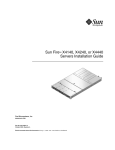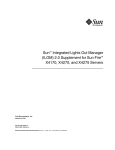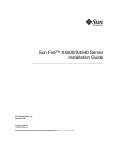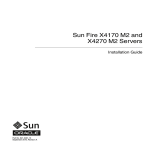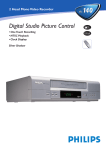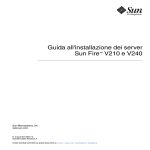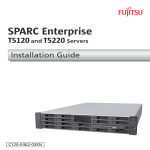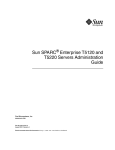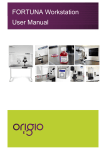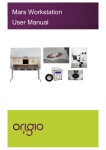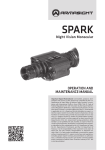Download Sun Fire X4140, X4240 and X4440 Servers Installation Guide
Transcript
Sun Fire X4140, X4240, or X4440 Servers Installation Guide TM Sun Microsystems, Inc. www.sun.com Part No. 820-2394-12 July 2009, Revision A Submit comments about this document at: http://www.sun.com/hwdocs/feedback Copyright © 2009 Sun Microsystems, Inc., 4150 Network Circle, Santa Clara, California 95054, U.S.A. All rights reserved. Unpublished - rights reserved under the Copyright Laws of the United States. THIS PRODUCT CONTAINS CONFIDENTIAL INFORMATION AND TRADE SECRETS OF SUN MICROSYSTEMS, INC. USE, DISCLOSURE OR REPRODUCTION IS PROHIBITED WITHOUT THE PRIOR EXPRESS WRITTEN PERMISSION OF SUN MICROSYSTEMS, INC. This distribution may include materials developed by third parties. Sun, Sun Microsystems, the Sun logo, Java, Solaris, Sun Fire 4140, Sun Fire 4240 and Sun Fire 4440 are trademarks or registered trademarks of Sun Microsystems, Inc. or its subsidiaries in the U.S. and other countries. AMD Opteron and Opteron are trademarks of Advanced Micro Devices, Inc. Intel is a registered trademark of Intel Corporation. This product is covered and controlled by U.S. Export Control laws and may be subject to the export or import laws in other countries. Nuclear, missile, chemical biological weapons or nuclear maritime end uses or end users, whether direct or indirect, are strictly prohibited. Export or reexport to countries subject to U.S. embargo or to entities identified on U.S. export exclusion lists, including, but not limited to, the denied persons and specially designated nationals lists is strictly prohibited. Use of any spare or replacement CPUs is limited to repair or one-for-one replacement of CPUs in products exported in compliance with U.S. export laws. Use of CPUs as product upgrades unless authorized by the U.S. Government is strictly prohibited. Copyright © 2009 Sun Microsystems, Inc., 4150 Network Circle, Santa Clara, California 95054, Etats-Unis. Tous droits réservés. Non publie - droits réservés selon la législation des Etats-Unis sur le droit d'auteur. CE PRODUIT CONTIENT DES INFORMATIONS CONFIDENTIELLES ET DES SECRETS COMMERCIAUX DE SUN MICROSYSTEMS, INC. SON UTILISATION, SA DIVULGATION ET SA REPRODUCTION SONT INTERDITES SANS L AUTORISATION EXPRESSE, ECRITE ET PREALABLE DE SUN MICROSYSTEMS, INC. Cette distribution peut inclure des éléments développés par des tiers . Sun, Sun Microsystems, le logo Sun, Java, Solaris et Sun Fire 4140, Sun Fire 4240, and Sun Fire 4440 sont des marques de fabrique ou des marques déposées de Sun Microsystems, Inc. ou ses filiales aux Etats-Unis et dans d'autres pays. AMD Opteron et Opteron sont marques déposées de Advanced Micro Devices, Inc. Intel est une marque déposée de Intel Corporation Ce produit est soumis à la législation américaine sur le contrôle des exportations et peut être soumis à la règlementation en vigueur dans d'autres pays dans le domaine des exportations et importations. Les utilisations finales, ou utilisateurs finaux, pour des armes nucléaires, des missiles, des armes biologiques et chimiques ou du nucléaire maritime, directement ou indirectement, sont strictement interdites. Les exportations ou reexportations vers les pays sous embargo américain, ou vers des entités figurant sur les listes d'exclusion d'exportation américaines, y compris, mais de maniere non exhaustive, la liste de personnes qui font objet d'un ordre de ne pas participer, d'une façon directe ou indirecte, aux exportations des produits ou des services qui sont régis par la législation américaine sur le contrôle des exportations et la liste de ressortissants spécifiquement désignés, sont rigoureusement interdites. L'utilisation de pièces détachées ou d'unités centrales de remplacement est limitée aux réparations ou à l'échange standard d'unités centrales pour les produits exportés, conformément à la législation américaine en matière d'exportation. Sauf autorisation par les autorités des EtatsUnis, l'utilisation d'unités centrales pour procéder à des mises à jour de produits est rigoureusement interdite. Contents Preface 1. vii Preparing for Installation Server Types 1 1 Disk Drive Locations 3 Tools and Equipment Needed Exterior Features 4 5 Front Panel Features for the Sun Fire X4140 Server Rear Panel Features for the Sun Fire X4140 Server 5 6 Front Panel Features for the Sun Fire X4240 and X4440 Servers Rear Panel Features for Sun Fire X4240, and X4440 Servers Safety Precautions ESD Precautions 8 9 9 Cabling Notes for Sun Fire X4140, X4240, and X4440 Servers Minimum Cable Connections AC Power Cables Ethernet Ports VGA Video Port 10 10 10 Network Management Ports USB Ports 7 10 11 11 11 iii Opening the Box Unpacking 11 11 Package Contents Inventory 12 Optional Component Installation Installation Overview 2. 12 12 Installing the Server in a Rack 15 Server Installation Process Overview 15 Toolless vs. Bolt-On Rail Assemblies Checking Compatibility Installing Slide Rails 16 16 17 Separate Mounting Bracket from Slide Rail 17 Installing the Mounting Brackets Onto the Server Attaching Toolless Slide Rail Assemblies 20 Attaching Bolt-On Slide-Rail Assemblies 20 18 Installing the Server Into the Slide-Rail Assemblies Installing the Cable Management Arm 25 Verifying Operation of the Slide Rails and CMA 31 Connecting Cables to the Sun Fire X4140 Server 32 Connector Locations 33 Ethernet Network Cables Serial Management Port 33 34 SP Network Management Port AC Power Cables VGA Video Port USB Ports 34 35 35 35 Connecting Cables to Sun Fire X4240 and X4440 Servers Connector Locations 36 Ethernet Network Cables iv 23 38 Sun Fire X4140, X4240 and X4440 Servers Installation Guide • July 2009 36 Serial Management Port 38 SP Network Management Port AC Power Cables VGA Video Port USB Ports 3. 39 40 40 Connecting to the Service Processor For Configuration Overview 42 ▼ Connecting to the ILOM Using the CLI ▼ Connecting to the ILOM Using SSH Using the ILOM Web GUI Preparing the System 44 49 49 Applying Standby Power Powering On the Server 50 50 To Power On the Server Powering Off the Server 5. 43 45 Powering the Server On and Off ▼ 41 42 Using the CLI 4. 39 50 51 Setting Up the Operating System Software 53 Configuring the Preinstalled Solaris Operating System Installation Worksheet 54 54 Configuring the Preinstalled Solaris 10 Operating System Before You Begin Procedure 58 58 58 Redirecting the Console Output to the Video Port (Optional) ▼ Connecting to the Server Using a Serial Capture Program Solaris 10 User Documentation Solaris 10 Training 60 60 61 61 Contents v Index vi 63 Sun Fire X4140, X4240 and X4440 Servers Installation Guide • July 2009 Preface This Sun Fire X4140, X4240, or X4440 Servers Installation Guide (820-2394) contains procedures for installing the Sun Fire X4140, X4240, or X4440 server in a rack, connecting to the service processor administrator account, and configuring the preinstalled Solaris™ Operating System. Using UNIX Commands This document might not contain information about basic UNIX® commands and procedures such as shutting down the system, booting the system, and configuring devices. Refer to the following for this information: ■ Software documentation that you received with your system. ■ Solaris Operating System documentation, which is at http://docs.sun.com. vii Shell Prompts Shell Prompt C shell machine-name% C shell superuser machine-name# Bourne shell and Korn shell $ Bourne shell and Korn shell superuser # Typographic Conventions Typeface* Meaning Examples AaBbCc123 The names of commands, files, and directories; on-screen computer output Edit your.login file. Use ls -a to list all files. % You have mail. AaBbCc123 What you type, when contrasted with onscreen computer output % su Password: AaBbCc123 Book titles, new words or terms, words to be emphasized. Replace command-line variables with real names or values. Read Chapter 6 in the User’s Guide. These are called class options. You must be superuser to do this. To delete a file, type rm filename. * The settings on your browser might differ from these settings. Related Documentation The document set for Sun Fire X4140, X4240, or X4440 servers is described in the Where to Find Sun Fire X4140, X4240, or X4440 Server Documentation sheet that is packed with your system. You can also find the documentation at http://docs.sun.com/app/docs/prod/server.x64 viii Sun Fire X4140, X4240 and X4440 Servers Installation Guide • July 2009 Translated versions of some of these documents are available at http://docs.sun.com. Select a language from the drop-down list and navigate to the Sun Fire X4140, X4240, or X4440 server document collection using the Product category link. Available translations for the Sun Fire X4140, X4240, or X4440 servers include Simplified Chinese, Traditional Chinese, French, Japanese, and Korean. English documentation is revised more frequently and might be more up-to-date than the translated documentation. For all Sun documentation, go to the following web site: http://docs.sun.com Product Updates For product updates that you can download, go to the following web site: http://www.sun.com/download/ Third-Party Web Sites Sun is not responsible for the availability of third-party web sites mentioned in this document. Sun does not endorse and is not responsible or liable for any content, advertising, products, or other materials that are available on or through such sites or resources. Sun will not be responsible or liable for any actual or alleged damage or loss caused by or in connection with the use of or reliance on any such content, goods, or services that are available on or through such sites or resources. Sun Welcomes Your Comments Sun is interested in improving its documentation and welcomes your comments and suggestions. You can submit your comments by going to: http://www.sun.com/hwdocs/feedback Preface ix Please include the title and part number of your document with your feedback. The part number of this Sun Fire X4140, X4240 and X4440 Servers Installation Guide is 8202394-12. x Sun Fire X4140, X4240 and X4440 Servers Installation Guide • July 2009 CHAPTER 1 Preparing for Installation Read the background information in this chapter before you attempt the installation procedures in Chapter 2 and Chapter 3. This chapter contains the following topics: ■ “Server Types” on page 1 ■ “Disk Drive Locations” on page 3 ■ “Tools and Equipment Needed” on page 4 ■ “Exterior Features” on page 5 ■ “Safety Precautions” on page 9 ■ “ESD Precautions” on page 9 ■ “Cabling Notes for Sun Fire X4140, X4240, and X4440 Servers” on page 10 ■ “Opening the Box” on page 11 ■ “Optional Component Installation” on page 12 ■ “Installation Overview” on page 12 Server Types There are three server types: ■ The Sun Fire X4140 server is a 1U rackmount server that provides two CPU sockets and eight hard drives. FIGURE 1-1 shows the Sun Fire X4140 server. 1 FIGURE 1-1 ■ The Sun Fire X4240 server is a 2U rackmount server that provides two CPU sockets and eight or sixteen hard drives. FIGURE 1-2 shows the Sun Fire X4240 server. FIGURE 1-2 2 Sun Fire X4140 Server Sun Fire X4240 Server Sun Fire X4140, X4240 and X4440 Servers Installation Guide • July 2009 ■ The Sun Fire X4440 server is a 2U rackmount server that supports two CPU sockets on the motherboard, plus an optional mezzanine board with two additional CPU sockets. It supports eight hard drives. FIGURE 1-3 shows the Sun Fire X4440 server. FIGURE 1-3 Sun Fire X4440 Server Disk Drive Locations Sun Fire X4140, X4240, and X4440 servers are available in the following drive configurations. ■ Sun Fire X4140 servers are available with eight drives. ■ Sun Fire X4240, and X4440 servers are available with eight or sixteen drives. Note – Hard disk drives or SSD drives may be installed. FIGURE 1-4 shows the drive locations and drive numbers. Chapter 1 Preparing for Installation 3 FIGURE 1-4 Sun Fire X4140, X4240, and X4440 Servers Drive Locations Tools and Equipment Needed To install Sun Fire X4140, X4240, and X4440 servers, you must have the following tools: ■ No. 2 Phillips screwdriver ■ Electrostatic discharge (ESD) mat and antistatic grounding strap (required if you install optional components) In addition, you must provide a system console device, such as one of the following: 4 ■ ASCII terminal ■ Sun workstation ■ Terminal server Sun Fire X4140, X4240 and X4440 Servers Installation Guide • July 2009 Exterior Features The following sections show the exterior features on the front and back of Sun Fire X4140, X4240, and X4440 servers. The exterior features include LEDs, ports, and hard drives. Front Panel Features for the Sun Fire X4140 Server FIGURE 1-5 1 3 Front Panel Features on the Sun Fire X4140 Server 2 5 4 6 7 9 8 10 13 11 14 12 15 16 Figure Legend 1 Locator LED/Locator button: white 9 HDD 5 2 Service Required LED: amber 10 HDD 4 3 Power/OK LED: green 11 HDD 6 4 Power button 12 HDD 7 5 HDD 1 13 DVD drive 6 HDD 0 14 USB 2 7 HDD 3 15 USB 3 8 HDD 2 16 Fault LEDs: amber Top open Power supply (PS) fail Over temperature warning, fan fail Chapter 1 Preparing for Installation 5 Rear Panel Features for the Sun Fire X4140 Server See FIGURE 1-6 and FIGURE 1-5 for the locations of the ports on the server. FIGURE 1-6 Rear Panel Features on the Sun Fire X4140 Server 16 15 1 2 3 18 17 4 5 6 7 8 9 19 10 11 Figure Legend 1 2 Power Supply 0 with LEDs: 7 Net Mgt port Power Supply OK: green 8 NET0 Power Supply Fail: amber 9 NET1 AC OK: green 10 NET2 Power Supply 1 with LEDs: 11 NET3 Power Supply OK: green 12 USB port 0 Power Supply Fail: amber 13 USB port 1 14 VGA video port 3 Locator LED Button AC OK: green 15 PS 0 4 Service Required LED 16 PS1 5 Power OK LED 17 PCIe 0 6 Ser Mgt port 18 PCIe 1 Note – USB ports 2 and 3 are located on the front panel (FIGURE 1-5). 6 Sun Fire X4140, X4240 and X4440 Servers Installation Guide • July 2009 12 13 14 Front Panel Features for the Sun Fire X4240 and X4440 Servers FIGURE 1-7 shows the front panel features on the Sun Fire X4240 and X4440 servers. Note – FIGURE 1-7 shows the eight drive model. The Sun Fire X4240 server is also available with sixteen drives. For drive locations and numbers, see FIGURE 1-4. FIGURE 1-7 1 2 3 4 Front Panel Features on the Sun Fire X4240, and X4440 Servers 5 6 7 Figure Legend 1 Locator LED/Locator button: white 5 DVD drive 2 Service Required LED: amber 6 USB Port 2 3 Power/OK LED: green 7 USB Port 3 4 Power button Chapter 1 Preparing for Installation 7 Rear Panel Features for Sun Fire X4240, and X4440 Servers FIGURE 1-8 shows the rear panel features on the Sun Fire X4240, and X4440 servers. FIGURE 1-8 Rear Panel Features on the Sun Fire X4240, and X4440 Servers 16 15 1 2 3 4 5 6 18 17 7 8 9 10 19 11 Figure Legend 1 Power Supply 0 7 Net Mgt port 2 Power Supply 1 8 NET0 3 Power Supply 0 Status LEDs 4 5 6 9 NET1 Power Supply OK: green 10 NET2 Power Supply Fail: amber 11 NET3 AC OK: green 12 USB port 0 13 USB port 1 Power Supply OK: green 14 VGA video port Power Supply Fail: amber 15 PCIe 0 AC OK: green 16 PCIe 3 Power Supply 1 Status LEDs System Status LEDs 17 PCIe 1 Power: green 18 PCIe 4 Service Required LED: amber 19 PCIe 2 AC OK LED: green 20 PCIe 5 Ser Mgt port Note – USB ports 2 and 3 are located on the front panel (FIGURE 1-7). 8 Sun Fire X4140, X4240 and X4440 Servers Installation Guide • July 2009 20 12 13 14 Safety Precautions Caution – If your rack has an antitilt bar, deploy it before beginning an installation. Caution – The server weighs approximately 40 lb (18 kg). Two people are required to lift and mount the system into a rack enclosure when using the procedures in this chapter. Caution – When completing a two-person procedure, always communicate your intentions clearly before, during, and after each step to minimize confusion. ESD Precautions Electronic equipment is susceptible to damage by static electricity. Use a grounded antistatic wriststrap, footstrap, or equivalent safety equipment to prevent electrostatic damage when you install or service the server. Caution – To protect electronic components from electrostatic damage, which can permanently disable the system or require repair by Sun service technicians, place components on an antistatic surface, such as an antistatic discharge mat, an antistatic bag, or a disposable antistatic mat. Wear an antistatic grounding strap connected to a metal surface on the chassis when you work on system components. Chapter 1 Preparing for Installation 9 Cabling Notes for Sun Fire X4140, X4240, and X4440 Servers Minimum Cable Connections Sun Fire X4140, X4240, and X4440 servers must have: ■ AC Power cables for the two system power supplies ■ A serial management port (SER MGT port) for the SP ■ A network management port (NET MGT port) for the SP ■ At least one system on-board Ethernet network connection (NET port) USB and VGA port connections are optional. AC Power Cables Caution – Do not attach power cables to the power supplies until you have finished connecting the data cables, and have connected the server to a serial terminal or a terminal emulator (PC or workstation). The server goes into standby power mode and the ILOM service processor initializes as soon as the AC power cables are connected to the power source. System messages might be lost after 60 seconds if the server is not connected to a terminal, PC, or workstation. Network Management Ports There are two network management ports for use with the ILOM service processor. 10 ■ A serial management port (labeled SER MGT) uses an RJ-45 cable and is always available. This is the default connection to the service processor. ■ A network management port (labeled NET MGT) is the optional connection to the service processor. This port is not available until you have configured network settings for the service processor (through the serial management port). See Chapter 3. The network management port uses an RJ-45 cable for a 10/100 BASET connection. This port does not support connections to Gigabit networks. Sun Fire X4140, X4240 and X4440 Servers Installation Guide • July 2009 Ethernet Ports Ethernet ports are labeled NET0, NET1, NET2, and NET3. The Ethernet interfaces operate at 10 Mbps, 100 Mbps, and 1000 Mbps. Transfer rates for the Ethernet ports are listed in TABLE 1-1. TABLE 1-1 Ethernet Connection Transfer Rates Connection Type IEEE Terminology Transfer Rate Ethernet 10BASE-T 10 Mbps Fast Ethernet 100BASE-TX 100 Mbps Gigabit Ethernet 1000BASE-T 1000 Mbps VGA Video Port Use a 15-pin video cable to connect to a VGA video device. USB Ports USB ports support hot-plugging. You can connect and disconnect USB cables and peripheral devices while the OS is running, without affecting system operations. ■ USB hot-plug operations are not supported when the system ok prompt is displayed or before the system has completed booting. ■ You can connect up to 126 devices to each of the two USB controllers, for a total of 252 USB devices per system. Opening the Box Carefully open the shipping box. Unpacking Unpack all server components from the packing cartons. Chapter 1 Preparing for Installation 11 Package Contents Inventory The following items should be packaged with the Sun Fire X4140, X4240, and X4440 server: ■ Sun Fire X4140, X4240, or X4440 server ■ Accessory kit, including the following documentation and media: ■ Welcome Letter ■ Sun Fire X4140, X4240, and X4440 Servers Installation Guide (this document) ■ Where to Find Sun Fire X4140, X4240, and X4440 Servers Documentation ■ Important Safety Information for Sun Hardware Systems ■ Additional license, safety, and registration documentation ■ Tools and Drivers CD (includes drivers and additional software) ■ DB9-RJ45 adapter (for serial system management port) ■ Optional rackmount kit (bolt-on or toolless) ■ Optional cable management kit Optional Component Installation Standard server components are installed at the factory. However, ordered options such as additional memory or PCI-e cards are shipped separately. If possible, install optional components before installing the server in a rack. If you ordered any options that are not factory-installed, refer to the service manual for your server for installation instructions. Note – The list of optional components can be updated without notice. See the web site for the most current list of components supported in the server. Power cables, keyboard, and mouse are packaged separately from the other items. Installation Overview To install a Sun Fire X4140, X4240, or X4440 server, perform these procedures in the following order. 12 Sun Fire X4140, X4240 and X4440 Servers Installation Guide • July 2009 1. Gather configuration information for your system. See your system administrator for specific details, including these parameters: ■ Netmask ■ IP address for the service processor ■ Gateway IP address 2. Open the box. See “Opening the Box” on page 11. 3. Install any optional Sun components shipped with your system. If you have purchased other optional components such as additional memory, install them prior to mounting the server in a rack. See “Optional Component Installation” on page 12. 4. Mount the server into a rack or cabinet. See Chapter 2 for details. Note – In the rest of this manual, the term rack means either an open rack or a closed cabinet. 5. Connect server cables. See “Connecting Cables to the Sun Fire X4140 Server” on page 32 or “Connecting Cables to Sun Fire X4240 and X4440 Servers” on page 36 for details. 6. Configure the service processor as described in Chapter 3. The service processor becomes operational when AC power is connected to the server. This mode, where the service processor is operational but the server is not powered-on, is called standby power mode. 7. Power on the server. See Chapter 4. Note – Chapter 4 describes how to power the server on and off. However, if you have not yet installed and configured your operating system, do not power on your server until you are instructed to do so by the operating system installation instructions. 8. Prepare the operating system. Do one of the following: ■ If you are going to use the preconfigured Solaris OS, see Chapter 5. ■ If you are going to install another operating systemsuch as Linux, VMware or a customized version of the Solaris operating system, refer to the Sun Fire X4140, X4240, and X4440 Servers Operating System Installation Guide. ■ If you are going to install the Windows operating system, refer to the Sun Fire X4140, X4240, and X4440 Servers Windows Operating System Installation Guide. Chapter 1 Preparing for Installation 13 14 Sun Fire X4140, X4240 and X4440 Servers Installation Guide • July 2009 CHAPTER 2 Installing the Server in a Rack This chapter describes how to install a Sun Fire X4140, X4240, or X4440 server into a rack using the rail assembly in the rackmount kit. Note – If your rackmount kit came with its own instructions, use the instructions in your rackmount kit instead of the instructions in this chapter. After performing the installation, proceed to Chapter 3 to configure the service processor. This chapter includes the following topics: ■ “Checking Compatibility” on page 16 ■ “Installing Slide Rails” on page 17 ■ “Installing the Cable Management Arm” on page 25 ■ “Verifying Operation of the Slide Rails and CMA” on page 31 ■ “Connecting Cables to the Sun Fire X4140 Server” on page 32 Note – In this guide, the term rack means either an open rack or a closed cabinet. Server Installation Process Overview To install your server into a four-post rack using the slide rail and cable management arm (CMA) options, perform the following tasks in the order shown: 1. “Checking Compatibility” on page 16 2. “Installing Slide Rails” on page 17 3. “Installing the Mounting Brackets Onto the Server” on page 18 15 4. “Installing the Cable Management Arm” on page 25 5. “Verifying Operation of the Slide Rails and CMA” on page 31 6. “Connecting Cables to the Sun Fire X4140 Server” on page 32 Toolless vs. Bolt-On Rail Assemblies The rack kits come in two varieties; toolless, or express rail kits, and bolt-on rail kits. ■ On the toolless rail kits, the rail assemblies snap onto the rack post without tools. ■ On the bolt-on rack kits, the installer must fasten the rail assemblies to the rack post using the connectors. The installer can select the correct hardware from a bag of connectors that is shipped with the rail kit. Checking Compatibility Check that your rack is compatible with the slide rail and cable management arm (CMA) options. The optional slide rails are compatible with a wide range of equipment racks that meet the following standards: TABLE 2-1 16 Rack Compatibility Item Requirement Structure Four-post rack (mounting at both front and rear). Two-post racks are not compatible. Rack horizontal opening and unit vertical pitch Conforms to ANSI/EIA 310-D-1992 or IEC 60927 standards. Distance between front and rear mounting planes Minimum 610 mm and Maximum 915 mm (24 inches to 36 inches). Clearance depth in front of front mounting plane Distance to front cabinet door is at least 25.4 mm (1 inch). Clearance depth behind front mounting plane Distance to rear cabinet door is at least 800 mm (31.5 inches) with the cable management arm, or 700 mm (27.5 inches), without the cable management arm. Sun Fire X4140, X4240 and X4440 Servers Installation Guide • July 2009 TABLE 2-1 Rack Compatibility (Continued) Item Requirement Clearance width between front and rear mounting planes Distance between structural supports and cable troughs is at least 456 mm (18 inches). Sun Fire X4140 server dimensions Length: (not including PSU handle): 28.125 inches (714 mm) Width: (not including ears): 16.75 inches (426 mm) Height: 1U 1.746 inches (44 mm) Sun Fire X4240 and X4440 server dimensions Length: (not including PSU handle): 28.125 inches (714 mm) Width: (not including ears): 16.75 inches (426 mm) Height: 2U 3.49 inches (88 mm) Caution – Always load equipment into a rack from the bottom up so that it will not become top-heavy and tip over. Deploy your rack’s anti-tip bar to prevent the rack from tipping during equipment installation. Caution – Ensure that the temperature in the rack does not exceed the server’s maximum ambient rated temperatures. Consider the total airflow requirements of all equipment installed in the rack to ensure that the equipment is operated within its specified temperature range. Refer to the service manual for the specified temperature range. Installing Slide Rails Separate Mounting Bracket from Slide Rail On some slide rail kits, the mounting bracket is shipped inside of the slide rail. If the mounting bracket is already separate from the slide rail, skip this procedure. To separate the mounting brackets from the slide rail: Chapter 2 Installing the Server in a Rack 17 1. Unpack the slide rails. 2. Locate the slide-rail lock at the front of one of the slide-rail assemblies, as shown in FIGURE 2-1. 3. Squeeze and hold the tabs at the top and bottom of the lock while you pull the mounting bracket out of the slide-rail assembly until it reaches the stop. 4. Push the mounting bracket release button toward the front of the mounting bracket, as shown in FIGURE 2-1, and simultaneously withdraw the mounting bracket from the slide-rail assembly. 5. Repeat for the remaining slide-rail assembly. FIGURE 2-1 Disassembling the Slide Rail Before Installation Mounting bracket release button Slide-rail lock Installing the Mounting Brackets Onto the Server To install the mounting brackets onto the sides of the server: 1. Position a mounting bracket against the chassis so that the slide-rail lock is at the server front, and the keyed openings on the mounting bracket are aligned with the locating pins on the side of the chassis. 18 Sun Fire X4140, X4240 and X4440 Servers Installation Guide • July 2009 FIGURE 2-2 Aligning the Mounting Bracket With the Server Chassis (Sun Fire X4140 Server Shown) Locating pins Mounting bracket clip Chassis front Keyed openings Slide-rail lock 2. Fasten the mounting bracket to the server: a. Align the heads of the locating pins with the keyed openings in the mounting bracket. See FIGURE 2-2. b. Place the mounting bracket on the pins so that it is flush with the side of the server, and the locating pins protrude through the holes on the mounting bracket. c. Slide the mounting bracket towards the front of the chassis until the bracket clip locks into place with an audible click. 3. Verify that the rear locating pin is securely fastened to the server. (See FIGURE 2-2.) 4. Repeat Step 1 through Step 3 to install the remaining mounting bracket on the other side of the server. Chapter 2 Installing the Server in a Rack 19 Attaching Toolless Slide Rail Assemblies To attach toolless slide-rail assemblies to the rack: 1. Position a slide-rail assembly in your rack so that the brackets at each end of the slide-rail assembly are on the outside of the front and rear rack posts. (See FIGURE 2-3.) 2. Push the slide-rail assembly against the rack. The toolless brackets latch to the rack post with an audible click. Attaching Bolt-On Slide-Rail Assemblies To attach bolt-on slide-rail assemblies to the rack: 1. Select hardware to match your rack posts from the bag of connectors that came with the slide rail kit. ■ If your rack has threaded mounting holes in the rack posts, first determine whether the threads are metric or standard, then select the correct screws. ■ If your rack does not have threaded mounting holes in the rack posts, use the caged nuts. If you use the caged nuts, press them into the holes from the outside of the rack until they clip into place. Once the caged nuts are in place, they provide threaded mounting holes. 2. Position a slide-rail assembly in your rack so that the brackets at each end of the slide-rail assembly are on the outside of the front and rear rack posts. (See FIGURE 2-3.) 3. Attach the slide-rail assembly loosely to the rack posts, but do not tighten the screws completely. 20 Sun Fire X4140, X4240 and X4440 Servers Installation Guide • July 2009 FIGURE 2-3 Slide-Rail Assembly Mounting to Rack Post Slide-rail assembly Rack post Slide-rail assembly bracket on outside of rack post 4. Repeat Step 1 through Step 3 for the remaining slide-rail assembly. 5. From the front of the rack, set the proper width of the rails with the rail-width spacer. (See FIGURE 2-4.) Note – The rail-width spacer, shown in FIGURE 2-4, is shipped with the bolt-on rail kit. Use it to set the rails to the proper width, then remove it. a. Insert the rail-width spacer into the slot on the inside of the slide rails. b. Tighten the screws to lock the rails firmly to the rack posts. c. Remove the rail-width spacer. d. Confirm that the rails are attached firmly to the rack. Chapter 2 Installing the Server in a Rack 21 FIGURE 2-4 Setting the Rail Width on the Front of the System Rail-width spacer 6. Repeat Step 5 for rear of the rack. On the rear of the rack, the slots for the rail-width spacer are on the inside of the rails, several inches from the ends. 22 Sun Fire X4140, X4240 and X4440 Servers Installation Guide • July 2009 7. If your rack includes an anti-tip foot, extend it from the bottom of the rack. (See FIGURE 2-5.) An anti-tip foot is typically required on racks that are not bolted in place. Caution – If your rack requires an anti-tip foot, and it is not extended, the rack could tip over. FIGURE 2-5 Extending the Anti-tip Foot Installing the Server Into the Slide-Rail Assemblies Use this procedure to install the server chassis, with mounting brackets, into the slide-rail assemblies that are mounted to the rack. Caution – This procedure requires a minimum of two people because of the weight of the server. Attempting this procedure alone could result in equipment damage or personal injury. Caution – Always load equipment into a rack from the bottom up so that it will not become top-heavy and tip over. 1. Push the slide rails into the slide-rail assemblies in the rack as far as possible. Chapter 2 Installing the Server in a Rack 23 2. Raise the server so that the rear ends of the mounting brackets are aligned with the slide-rail assemblies that are mounted in the equipment rack. (See FIGURE 2-6.) 3. Insert the server with mounting brackets into the slide rails, then push the server into the rack slowly, until the mounting brackets meet the slide-rail stops (approximately 12 inches, or 30 cm). Push the server with mounting brackets gently. It will stop abruptly. FIGURE 2-6 Inserting the Server With Mounting Brackets Into the Slide Rails (Sun Fire X4140 Server Shown) Mounting bracket inserted into slide rail Slide-rail release button Slide-rail lock Slide-rail assembly mounted on rack post 4. Simultaneously push both slide-rail release buttons towards the back of the rack, while pushing the server into the rack. (See FIGURE 2-6.) 5. Continue pushing until the front of the server is flush with the rack posts. The slide-rail lock will latch, securing the server in place with an audible click. 6. Verify that the slide rails work correctly. See FIGURE 2-7. 24 Sun Fire X4140, X4240 and X4440 Servers Installation Guide • July 2009 a. Press the slide-rail release buttons while pulling the server out from the rack. The server should slide about half way out of the rack, then stop. b. Simultaneously press the gray slide rail release tabs while pulling the server further out from the rack. The server should pull the rest of the way out of the rack, until the slide rails are fully extended. FIGURE 2-7 Location of Slide Rail Release Tabs Slide-rail release button Caution – Verify that the server is securely mounted in the rack and that the sliderail locks are engaged with the mounting brackets before continuing. c. Once you have verified the function of the slide rails, slide the server back fully into the rack until the slide-rail lock engages. Installing the Cable Management Arm Use this procedure to install an optional cable management arm (CMA). FIGURE 2-8 shows the CMA. Chapter 2 Installing the Server in a Rack 25 FIGURE 2-8 Cable Management Arm (CMA) CMA rail extension 1. Unpack the CMA parts. 2. Take the CMA to the back of the equipment rack and ensure that you have adequate room to work around the back of the server. Note – References to “left” or “right” in this procedure assume that you are facing the back of the equipment rack. 3. If the CMA rail extension is taped to the CMA arm, remove the tape. 4. Attach the CMA rail extension to the left slide rail until the extension locks into place with an audible click. (See FIGURE 2-9.) 26 Sun Fire X4140, X4240 and X4440 Servers Installation Guide • July 2009 FIGURE 2-9 Inserting the CMA Rail Extension Into the Back of the Left Slide Rail CMA rail extension Chapter 2 Left slide rail Installing the Server in a Rack 27 5. Verify that the CMA rail extension engages the slide rail, as shown in FIGURE 2-9. Note – Support the CMA in the remaining installation steps. Do not allow the arm to hang by its own weight until it is secured by all three attachment points. 6. Insert the CMA’s mounting bracket connector into the right slide rail until the connector locks into place with an audible click. (See FIGURE 2-10.) FIGURE 2-10 Inserting the CMA Mounting Bracket Into the Back of the Right Slide Rail Right slide rail CMA mounting bracket 7. Insert the right CMA slide-rail connector into the right slide-rail assembly until the connector locks into place with an audible click. (See FIGURE 2-11.) 28 Sun Fire X4140, X4240 and X4440 Servers Installation Guide • July 2009 FIGURE 2-11 Inserting CMA Slide-Rail Connector Into the Back of the Right Slide-Rail Assembly Right sliderail assembly CMA slide-rail connector Chapter 2 Installing the Server in a Rack 29 8. Insert the left CMA slide-rail connector into the rail extension on the left sliderail assembly until the connector locks into place with an audible click. (See FIGURE 2-12.) Note – In the closed position, the CMA covers the server’s power supply connectors, which are located on the left-rear of the chassis. To access them, release the CMA arm connector and swing the CMA out of the way. FIGURE 2-12 Connecting the CMA Arm to the Rail Extension Connector CMA arm connector CMA extension arm (on left slide rail) 9. Install and route cables to your server, as required. 30 Sun Fire X4140, X4240 and X4440 Servers Installation Guide • July 2009 10. Attach the hook and loop straps to the CMA, and press them into place to secure the cables. (See FIGURE 2-13.) For best results, place three hangers, evenly spaced, on the rear-facing side of the CMA and three on the side facing the server. FIGURE 2-13 Installing CMA Cable Straps CMA arm CMA cable hanger 11. Attach the right outer latch. 12. Attach the support latch to the left CMA extension. Verifying Operation of the Slide Rails and CMA Use this procedure to ensure that the slide rails and CMA are operating correctly. Chapter 2 Installing the Server in a Rack 31 Note – Two people are recommended for this procedure: one to move the server into and out of the rack, and one to observe the cables and CMA. 1. Slowly pull the server out of the rack until the slide rails reach their stops. 2. Inspect the attached cables for any binding or kinks. 3. Verify that the CMA extends fully from the slide rails. 4. Push the server back into the rack, as described in the following sub-steps. When the server is fully extended, you must release two sets of slide-rail stops to return the server to the rack: a. The first set of stops are released by sliding the green release mechanism, located on the inside of each slide rail, just behind the back panel of the server. Push in both sides simultaneously and slide the server toward the rack. The server will slide in approximately 18 inches (46 cm) and stop. Verify that the cables and the CMA retract without binding before you continue. b. The second set of stops are the slide-rail release buttons, located near the front of each mounting bracket. See FIGURE 2-6. Simultaneously push or pull both of the slide-rail release buttons, and push the server completely into the rack until both slide-rail locks engage. c. Adjust the cable straps and CMA as required. Connecting Cables to the Sun Fire X4140 Server Connect cables to the server as described in the following sections. ■ “Ethernet Network Cables” on page 33 ■ “Serial Management Port” on page 34 ■ “SP Network Management Port” on page 34 ■ “AC Power Cables” on page 35 ■ “VGA Video Port” on page 35 ■ “USB Ports” on page 35 Refer to “Cabling Notes for Sun Fire X4140, X4240, and X4440 Servers” on page 10. 32 Sun Fire X4140, X4240 and X4440 Servers Installation Guide • July 2009 Note – When you are finished connecting the cables to the server, ensure that the server can slide smoothly into and out of the rack without binding or damaging the cables. See the section, “Verifying Operation of the Slide Rails and CMA” on page 31. Connector Locations FIGURE 2-14 shows the connectors on the rear panel of the server. FIGURE 2-14 1 Sun Fire X4140 Rear Panel Features 2 3 4 5 6 7 8 9 10 11 12 13 14 Figure Legend 1 Power Supply 0 8 NET0 2 Power Supply 1 9 NET1 3 Locator LED Button 10 NET2 4 Service Required LED 11 NET3 5 Power OK LED 12 USB port 0 6 Ser Mgt port 13 USB port 1 7 Net Mgt port 14 Video VGA port Ethernet Network Cables The Sun Fire X4140 server has four RJ-45 Gigabit Ethernet connectors, marked NET0, NET1, NET2, and NET3 (FIGURE 2-14). 1. Connect a Category 5 cable from your network switch or hub to Ethernet Port 0 (NET0) on the rear of the chassis. 2. Connect Category 5 cables from your network switch or hub to the remaining Ethernet ports (NET1, NET2, NET3), as needed. Chapter 2 Installing the Server in a Rack 33 Serial Management Port The serial management port is marked SER MGT (FIGURE 2-15). It provides a serial connection to the service processor. FIGURE 2-15 Serial and Network Ports – Rear of Chassis SER MGT NET MGT Note – Use the serial management port only for server management. It is the default connection between the service processor and a terminal or a computer. Caution – Do not attach a modem to this port. ● Connect a Category 5 cable from the SER MGT serial management port to the terminal device. When connecting either a DB-9 or a DB-25 cable, use an adapter to perform the crossovers given for each connector. The default serial protocol is 9600 baud, no parity, with no hardware or software flow control. SP Network Management Port The SP network management port is marked NET MGT (FIGURE 2-15). It provides a network connection to the service processor. Note – The network management port is configured by default to retrieve network settings via Dynamic Host Configuration Protocol (DHCP), and to allow connections using Solaris Secure Shell (SSH). You might need to modify these settings for your network. Instructions are given in Chapter 3. 34 Sun Fire X4140, X4240 and X4440 Servers Installation Guide • July 2009 ● Connect a Category 5 cable from the NET MGT network management port to your network switch or hub. AC Power Cables ● Connect AC power cables to power supply 0 and power supply 1, as shown in FIGURE 2-14. Caution – Do not turn on system power yet. When you connect AC power to the server, the server automatically enters standby power mode. The service processor starts, but the server remains powered off. The Power/OK LED on the front panel flashes. Note – When the CMA is installed, it covers the AC power connectors. To access the power connectors, release the CMA arm connector on the left side of the CMA, and swing the CMA out of the way. See FIGURE 2-12. For more complete information about powering the system on and off, see Chapter 4. VGA Video Port The video port connector uses a HD-15 connector, which is located at the lower right corner of the rear panel (FIGURE 2-14). USB Ports Four Universal Serial Bus (USB) ports are provided. USB ports 0 and 1 are located on the rear of the chassis (FIGURE 2-14). Ports 2 and 3 on the front of the chassis. Chapter 2 Installing the Server in a Rack 35 Connecting Cables to Sun Fire X4240 and X4440 Servers Connect cables to the server as described in the following sections. ■ “Ethernet Network Cables” on page 38 ■ “Serial Management Port” on page 38 ■ “SP Network Management Port” on page 39 ■ “AC Power Cables” on page 39 ■ “VGA Video Port” on page 40 ■ “USB Ports” on page 40 Refer to “Cabling Notes for Sun Fire X4140, X4240, and X4440 Servers” on page 10. Note – When you are finished connecting the cables to the server, ensure that the server can slide smoothly in and out of the rack without binding or damaging the cables. See the section, “Verifying Operation of the Slide Rails and CMA” on page 31. Connector Locations FIGURE 2-16 shows the connectors and power supplies on the back of the Sun Fire X4240 and X4440 servers. FIGURE 2-16 1 36 2 Sun Fire X4240 and X4440 Rear Panel Features 3 4 5 6 7 8 9 10 11 Sun Fire X4140, X4240 and X4440 Servers Installation Guide • July 2009 12 13 14 Figure Legend 1 Power Supply 0 8 NET0 NET1 2 Power Supply 1 9 3 Locator LED Button 10 NET2 4 Service Required LED 11 NET3 5 Power OK LED 12 USB port 0 6 Ser Mgt port 13 USB port 1 7 Net Mgt port 14 VGA video port USB ports 2 and 3 are located on the front panel (FIGURE 2-17). FIGURE 2-17 Sun Fire X4240 and X4440 Front Panel USB Ports 1 2 Figure Legend 1 USB Port 2 2 USB Port 3 Ethernet Network Cables The servers have four RJ-45 Gigabit Ethernet network connectors. They are marked NET0, NET1, NET2, and NET3 (FIGURE 2-18). Chapter 2 Installing the Server in a Rack 37 FIGURE 2-18 Ethernet Network Connections 1. Connect a Category 5 cable from your network switch or hub to Ethernet Port 0 (NET0) on the rear of the chassis. 2. As needed, connect Category 5 cables from your network switch or hub to the remaining Ethernet ports (NET1, NET2, NET3). Serial Management Port The serial management port is marked SER MGT (FIGURE 2-18). It is the leftmost RJ45 port on the rear of the chassis. This port provides a serial connection to the service processor. Note – Use the serial management port only for server management. It is the default connection between the service processor and a terminal or a computer. Caution – Do not attach a modem to this port. ● Connect a Category 5 cable from the serial management port to the terminal device. When connecting either a DB-9 or a DB-25 cable, use an adapter to perform the crossovers given for each connector. 38 Sun Fire X4140, X4240 and X4440 Servers Installation Guide • July 2009 SP Network Management Port The SP network management port is marked NET MGT (FIGURE 2-18). It provides a network connection to the service processor. It is the RJ-45 port above the rear USB ports. ● Connect a Category 5 cable from your network switch or hub to the Network Management Port. Note – This port is not operational until you configure the network settings (through the serial management port), as described in Chapter 3. Note – The network management port is configured by default to retrieve network settings via Dynamic Host Configuration Protocol (DHCP) and to allow connections using Solaris Secure Shell (SSH). You might need to modify these settings for your network. Instructions are given in Chapter 3. AC Power Cables ● Connect AC power cables to power supply 0 and power supply 1. See FIGURE 2-18. Caution – Do not turn on system power yet. When you connect AC power to the server, the server automatically enters power mode. The service processor starts, but the server remains powered off. The Power/OK LED on the front panel flashes. Note – When the CMA is installed, it covers the AC power connectors. To access the power connectors, release the CMA arm connector on the left side of the CMA, and swing the CMA out of the way. See FIGURE 2-12. For more complete information about powering the system on and off, see Chapter 4. Chapter 2 Installing the Server in a Rack 39 VGA Video Port The video port connector uses a HD-15 connector, which is located at the lower right corner of the rear panel (FIGURE 2-16). USB Ports Four Universal Serial Bus (USB) ports are provided. USB ports 0 and 1 are located on the rear of the chassis (FIGURE 2-16). Ports 2 and 3 are on the front of the chassis (FIGURE 2-17). 40 Sun Fire X4140, X4240 and X4440 Servers Installation Guide • July 2009 CHAPTER 3 Connecting to the Service Processor For Configuration This chapter describes how to connect to the Sun Fire X4140, X4240, or X4440 server’s Integrated Lights Out Manager (ILOM) service processor (SP), and how to perform initial network configuration. ■ “Overview” on page 42 ■ “Using the CLI” on page 42 ■ “Using the ILOM Web GUI” on page 45 41 Overview The ILOM provides a connection to the system console and can be used to perform network management and configuration functions. It can be used when the system is powered off, as long as the AC power is connected. This chapter describes how to connect to the service processor to ensure that it is working correctly and to configure its network settings. You can configure the service processor to use DHCP or a static IP address. If you configure it to use a static IP address, you must enter the network address settings. The service processor is described fully in the Sun Integrated Lights Out Manager User's Guide. The ILOM provides two control interfaces; the command-line interface (CLI), and the web GUI. ■ The CLI can be accessed through a serial cable via the SER MGT port, or a secure SSH connection via the NET MGT port. ■ The Web GUI is accessed through a web browser over the Ethernet connection through the NET MGT port. The connections appear in FIGURE 2-14 and FIGURE 2-16. Either method can be used to configure your network settings. However, to use SSH or the web GUI, you must already know your service processor’s IP address. Use the procedure that you prefer: ■ “Using the CLI” on page 42 ■ “Using the ILOM Web GUI” on page 45 Using the CLI Use this procedure to establish a serial connection to the ILOM, then to perform initial network configuration. This procedure assumes that you have already completed the hardware setup and have applied standby power to your server. 42 ■ If you do not know your ILOM’s IP address, use a serial connection. ■ If you know the ILOM’s IP address, you can use either a serial connection or SSH. Sun Fire X4140, X4240 and X4440 Servers Installation Guide • July 2009 ▼ Connecting to the ILOM Using the CLI 1. Verify that your terminal, laptop, or terminal server is operational. 2. Configure the terminal device or the terminal emulation software running on a laptop or PC to the following settings: ■ 8N1: eight data bits, no parity, one stop bit ■ 9600 baud ■ Disable hardware flow control (CTS/RTS) ■ Disable software flow control (XON/XOFF) 3. Connect a serial cable from the RJ-45 SER MGT port on the server’s back panel to a terminal device. See FIGURE 1-6 or FIGURE 1-8. 4. Press Enter on the terminal device to establish a connection between the terminal device and the ILOM. The SP displays its login prompt: login 5. Log in to the ILOM. a. Type the default user name: root b. Type the default password: changeme. Once you have successfully logged in, the SP displays its default command prompt: -> You can now use the SP’s command line interface (CLI). 6. Configure the server’s network settings: a. Navigate to the CLI’s network settings. Type: /SP/network b. Type the following commands to configure the network settings: ■ To configure a static IP address, type: set pendingipaddress=xxx.xxx.xx.xx set pendingipnetmask=yyy.yyy.yyy.y set pendingipgateway=zzz.zzz.zz.zzz set pendingipdiscovery=static set commitpending=true Where xxx.xxx.xx.xx, yyy.yyy.yyy.y and zzz.zzz.zz.zzz are the IP address, netmask, and gateway for your ILOM and network configuration. ■ To configure a dynamic IP address, type: Chapter 3 Connecting to the Service Processor For Configuration 43 set pendingipdiscovery=dhcp set commitpending=true 7. (Optional) Start the serial console. ■ To start the serial console, you can type: cd /SP/console start ■ To switch back to the ILOM CLI, enter the Esc ( key sequence. 8. When you are done, type exit. The ILOM exits. 9. After configuring the ILOM, continue with Chapter 5. ▼ Connecting to the ILOM Using SSH This procedure assumes that: ■ You are connected to a command-line device that has access to the same subnet as the ILOM, ■ You know the ILOM’s IP address. 1. Enter the command: ssh -l root@ipaddress where ipaddress is the ILOM IP address. 2. When prompted, enter the default password, changeme. Once you have successfully logged in, the SP displays its default command prompt: -> You can now use the SP’s command-line interface (CLI). 3. Configure the server’s network settings: a. Navigate to the CLI’s network settings. Type: /SP/network b. Type the following commands to configure the network settings: ■ To configure a static IP address, type: set pendingipaddress=xxx.xxx.xx.xx set pendingipnetmask=yyy.yyy.yyy.y set pendingipgateway=zzz.zzz.zz.zzz 44 Sun Fire X4140, X4240 and X4440 Servers Installation Guide • July 2009 set pendingipdiscovery=static set commitpending=true Where xxx.xxx.xx.xx, yyy.yyy.yyy.y and zzz.zzz.zz.zzz are the IP address, netmask, and gateway for your ILOM and network configuration. ■ To configure a dynamic IP address, type: set pendingipdiscovery=dhcp set commitpending=true 4. (Optional) start the serial console. ■ To start the serial console, you can type: cd /SP/console start ■ To switch back to the ILOM CLI, enter the Esc ( key sequence. 5. When you are done, type exit. The ILOM exits. 6. After configuring the ILOM, continue with Chapter 5. Using the ILOM Web GUI To access the full range of ILOM functionality such as the graphical user interface (GUI), you must connect a LAN to the Ethernet port and access the ILOM web GUI. Note – This procedure assumes that you have already completed the hardware setup and have applied standby power for your server. It also assumes that you know the ILOM’s IP address. 1. If you are going to use DHCP, ensure that your DHCP server is configured to accept new media access control (MAC) addresses by checking with your system administrator. 2. Connect an Ethernet cable to the server’s RJ-45 NET MGT Ethernet port. See See FIGURE 1-6 or FIGURE 1-8. Chapter 3 Connecting to the Service Processor For Configuration 45 Note – If the ILOM is not using static IP addresses, it broadcasts a DHCPDISCOVER packet with the ID of its MAC address. A DHCP server on your LAN returns a DHCPOFFER packet containing an IP address and other information. The ILOM then manages its “lease” of that IP address that was assigned to it by the DHCP server. 3. If you do not know the ILOM IP address, use the procedure in “Using the CLI” on page 42 to find it. 4. Type the ILOM IP address in a web browser window. The login page appears. 5. Enter the default user name and password, root and changeme. The ILOM web GUI page appears. 6. To configure the network settings, select the Configuration tab and its Network tab. The current network settings appear. See FIGURE 3-1. 7. Select and configure the IP address: a. To use DHCP, select the radio button next to Obtain an IP Address Automatically (use DHCP). b. To use a static IP address: i. Select the radio button next to Use the Following IP Address. ii. Enter the IP address, subnet mask, and gateway IP address in the corresponding fields. 46 Sun Fire X4140, X4240 and X4440 Servers Installation Guide • July 2009 FIGURE 3-1 Integrated Lights Out Manager Network Settings Page 8. Click Save when you are done. 9. Continue with Chapter 5. For detailed instructions on configuring your system, see the Sun Integrated Lights Out Manager User's Guide. Chapter 3 Connecting to the Service Processor For Configuration 47 48 Sun Fire X4140, X4240 and X4440 Servers Installation Guide • July 2009 CHAPTER 4 Powering the Server On and Off This chapter describes how to power your Sun Fire X4140, X4240, or X4440 server on and off. ■ “Preparing the System” on page 49 ■ “Applying Standby Power” on page 50 ■ “Powering On the Server” on page 50 ■ “Powering Off the Server” on page 51 Preparing the System Ensure that AC power is connected to the server as described in Chapter 2. Caution – A maximum of two power cords can be connected to a single branch circuit. The remaining power cord(s) must be connected to a second branch circuit. Caution – If you are connecting your server for the first time, do not power on the system until you are instructed to do so in Chapter 5. Caution – Possible equipment damage. Do not operate the server without all fans, component heatsinks, air baffles, and the cover installed. Severe damage to server components can occur if operated without adequate cooling mechanisms. 49 Applying Standby Power When you connect AC power to the server, the server automatically enters standby power mode. The service processor starts, but the server remains powered-off. The Power/OK LED on the front panel flashes. If you are starting the server for the first time, configure the service processor as described in Chapter 3. Powering On the Server Caution – If you have not yet installed your operating system, do not turn on system power yet. To install an operating system, before powering on the server, perform one of the following processes: ■ To install the preinstalled Solaris operating system, see Chapter 5. ■ To install a supported Linux or VMware operating system, refer to the Sun Fire X4140, X4240, and X4440 Servers Operating System Installation Guide. ■ To install a supported Windows operating system, refer to the Sun Fire X4140, X4240, and X4440 Servers Windows Operating System Installation Guide. ▼ To Power On the Server 1. Verify that power cords have been connected and that standby power is on. In standby power mode, the Power/OK LED on the front panel flashes. Note – When the CMA is installed, it covers the AC power connectors. To access the power connectors, release the CMA arm connector on the left side of the CMA, and swing the CMA out of the way. See FIGURE 2-12. 50 Sun Fire X4140, X4240 and X4440 Servers Installation Guide • July 2009 2. Use a pointed object to press and release the recessed Power button on the server front panel. See FIGURE 4-1. When main power is applied to the full server, the Power/OK LED next to the Power button lights and remains lit. FIGURE 4-1 Front Panel (Sun Fire X4140 Server Shown) 1 2 Figure Legend 1 Power Button 2 Power/OK LED Powering Off the Server ● To power off the server from main power mode, use one of the following two methods: ■ Graceful shutdown: Use a pointed object to press and release the Power button on the front panel. This causes Advanced Configuration and Power Interface (ACPI) enabled operating systems to perform an orderly shutdown of the operating system. Servers not running ACPI-enabled operating systems will shut down to standby power mode immediately. ■ Emergency shutdown: Press and hold the Power button for four seconds to force main power off and enter standby power mode. When main power is off, the Power/OK LED on the front panel will begin flashing, indicating that the server is in standby power mode. Note – To completely power off the server, you must disconnect the AC power cords from the back panel of the server. When the CMA is installed, it covers the AC power connectors. To access the power connectors, release the CMA arm connector on the left side of the CMA, and swing the CMA out of the way. See FIGURE 2-12. Caution – Do not disconnect the AC power cords from the system while it is powered-on. Chapter 4 Powering the Server On and Off 51 52 Sun Fire X4140, X4240 and X4440 Servers Installation Guide • July 2009 CHAPTER 5 Setting Up the Operating System Software After configuring the ILOM with network settings as described in Chapter 3, you can configure the preinstalled Solaris™ 10 operating system (OS), or install a Linux or Windows platform operating system. Use the appropriate reference below, depending on which OS you want to use: ■ If you want to use the preinstalled Solaris 10 OS, see “Configuring the Preinstalled Solaris Operating System” on page 54. ■ If you want to install a supported Linux OS and the required drivers, refer to the Sun Fire X4140, X4240, and X4440 Servers Operating System Installation Guide . This document also contains procedures for installing the Solaris operating system from media. ■ If you want to install a supported Windows OS and the required drivers, refer to the Sun Fire X4140, X4240, and X4440 Servers Windows Operating System Installation Guide. ■ For additional OS considerations specific to your server, refer to the Sun Fire X4140, X4240, and X4440 Servers Product Notes. 53 Configuring the Preinstalled Solaris Operating System This section contains information and procedures for configuring the Solaris 10 Operating System (OS) that has been preinstalled on your server. Note – Unlike with SPARC® systems, you will not see the output of the preinstalled Solaris 10 image through a monitor when you power on the server. The output of the preinstalled image is directed to a serial console instead of a monitor that is attached to the server. To configure the preinstalled Solaris OS: 1. Use the worksheet in TABLE 5-1 to gather the configuration information that you need. 2. Configure the OS. Installation Worksheet Use the worksheet in TABLE 5-1 to gather the information that you need to configure the preinstalled Solaris 10 OS. You only need to collect the information that applies to your application of the system. 54 Sun Fire X4140, X4240 and X4440 Servers Installation Guide • July 2009 TABLE 5-1 Installation Worksheet Your Answers: Defaults are noted with an asterisk. (*) Information for Installation Description or Example Language Choose from the list of available languages for the Solaris 10 software. English* Locale Choose your geographic region from the list of available locales. English (C - 7-bit ASCII)* Terminal Choose the type of terminal that you are using from the list of available terminal types. Network connection Is the system connected to a network? • Networked • Non-networked* DHCP Can the system use Dynamic Host Configuration Protocol (DHCP) to configure its network interfaces? • Yes • No* IP address If you are not using DHCP, note the network address Subnet If you are not using DHCP, supply the IP address for the system. Example: 129.200.9.1 IPv6 If you are not using DHCP, is the system part of a subnet? If yes, what is the netmask of the subnet? Example: 255.255.0.0 255.255.0.0* Do you want to enable IPv6 on this machine? • Yes • No* Host name A host name that you choose for the system. Kerberos Do you want to configure Kerberos security on this • Yes machine? • No* If yes, gather the following: Default Realm: Administration Server: First KDC: (Optional) Additional KDCs: Chapter 5 Setting Up the Operating System Software 55 TABLE 5-1 Installation Worksheet (Continued) Information for Installation Description or Example Name service: if the system uses a name service, provide the following information. Name service Which name service should this system use? Domain name Provide the name of the domain in which the system resides. NIS+ and NIS Do you want to specify a name server or let the installation program find one? DNS Provide IP addresses for the DNS server. You must enter at least one IP address, but you can enter up to three addresses. You can also enter a list of domains to search when a DNS query is made. Search Domain: Search Domain: Search Domain: LDAP 56 Provide the following information about your LDAP profile: Profile name: Profile server: If you specify a proxy credential level in your LDAP profile, gather the following: Proxy-Bind Distinguished Name: Proxy-Bind Password: Sun Fire X4140, X4240 and X4440 Servers Installation Guide • July 2009 Your Answers: Defaults are noted with an asterisk. (*) • • • • • NIS+ NIS DNS LDAP None* • Specify One • Find One* TABLE 5-1 Installation Worksheet (Continued) Your Answers: Defaults are noted with an asterisk. (*) Information for Installation Description or Example Default route Do you want to specify a default route IP address or let the Solaris installation program find one? The default route provides a bridge that forwards traffic between two physical networks. An IP address is a unique number that identifies each host on a network. You have the following choices: • You can specify the IP address. An /etc/defaultrouter file is created with the specified IP address. When the system is rebooted, the specified IP address becomes the default route. • You can let the Solaris installation program detect an IP address. However, the system must be on a subnet that has a router that advertises itself by using the ICMP router discovery protocol. If you are using the command-line interface, the software detects an IP address when the system is booted. • You can choose None if you do not have a router or do not want the software to detect an IP address at this time. The software automatically tries to detect an IP address on reboot. • Specify One • Detect One • None* Time zone How do you want to specify your default time zone? • Geographic region* • Offset from GM • Time zone file Root password Choose a root password for the system. Chapter 5 Setting Up the Operating System Software 57 Configuring the Preinstalled Solaris 10 Operating System Use the information that you gathered in “Installation Worksheet” on page 54 as you perform the configuration. In this procedure, you connect to the service processor CLI, and use it to access the system console. You can do this using two methods: ■ A client system running SSH (method 1). ■ A serial cable connected directly to the server (method 2). Note – The system console screen should remain blank until the system is powered on. Before You Begin If you are going to use SSH (method 1), the following conditions must be present: ■ The communication properties of the serial port of the system must be set to the defaults: 9600 baud, 8N1 (eight data bits, no parity, one stop bit), disable flow control. ■ You must have an Ethernet connection to the same subnet as the NET MGT port connected to the service processor. ■ You must know the service processor’s IP address. If these conditions are not present, use a serial cable (method 2). Refer to the Sun Integrated Lights Out Manager User's Guide for more details. Procedure 1. Connect to the service processor using one of the following methods: Method 1: To connect using SSH: a. Open an SSH client. b. Type the following command: ssh -l root <sp_ip_address> The service processor displays its login prompt. Method 2: To connect using a serial cable and a terminal capture program: 58 Sun Fire X4140, X4240 and X4440 Servers Installation Guide • July 2009 a. Use a cable to connect the serial port of the server to the serial port of the serial capture host system. b. Start a terminal session to capture the serial port output: ■ On a client running Solaris OS, type: $tip -9600 /dev/ttya ■ On a client running Windows, start a program such as Hyperterminal. ■ On a client running Linux, start a program such as Minicom, a text-based serial communication program that is included in the Linux distributions. For more information, see the man pages included in the Linux distribution. The service processor displays its login prompt. 2. Log in to the service processor as an Administrator, for example: login: root password: changeme The service processor displays its prompt: -> 3. Start the system console by typing the following: start /SP/console The system console remains inactive (blank) until you turn on the system power. 4. Use a pointed object to press and release the recessed Power button on the server front panel. See FIGURE 4-1 for the location of the Power button. Messages scroll by on the system console screen. 5. Follow the Solaris 10 onscreen prompts. 6. Use the information gathered in the “Installation Worksheet” on page 54 to help you enter the system and network information as you are prompted. The screens that are displayed vary, depending on the method that you chose for assigning network information to the server (DHCP or static IP address). After you have entered the system configuration information, the server posts a warning then reboots the system. When it reboots, the Solaris login prompt appears. The installation is complete. Chapter 5 Setting Up the Operating System Software 59 Redirecting the Console Output to the Video Port (Optional) Caution – This procedure is intended for advanced users of Solaris only. You can seriously disrupt the proper functioning of the server or render the server unbootable if you introduce a problem in the bootenv.rc file. After completing the preceding steps and while logged in to the SP, if you wish to redirect the console output to the video port, run the eeprom command at the prompt using the following arguments: /eeprom console=text/ ▼ Connecting to the Server Using a Serial Capture Program 1. Use a cable to connect the serial port of the server to the serial port of the serial capture host system. 2. Make sure the communication properties of the serial port of the system are set to the default. The default settings are 9600 baud, 8N1 (eight data bits, no parity, one stop bit), disable flow control. 3. Start a terminal session to capture the serial port output: On a client running Solaris OS, type: $tip -9600 /dev/ttya On a client running Windows, start a program such as Hyperterminal. On a client running Linux, start a program such as Minicom, a text-based serial communication program that is included in the Linux distributions. For more information, see the man pages included in the Linux distribution. 4. Log in to the service processor as an Administrator, for example: login: root password: changeme The service processor displays its prompt: -> 5. Start the serial console by typing the following: start /SP/console 60 Sun Fire X4140, X4240 and X4440 Servers Installation Guide • July 2009 6. Power on main power to the server by using a pointed object to press the recessed Power button on the front panel. POST messages appear on your screen as the OS boots up. 7. Follow the Solaris 10 onscreen prompts. 8. Use the information gathered in the “Installation Worksheet” on page 54 to help you enter the system and network information as you are prompted. The screens that are displayed vary, depending on the method that you chose for assigning network information to the server (DHCP or static IP address). After you have entered the system configuration information, the server completes the boot process and displays the Solaris login prompt. Solaris 10 User Documentation You can access the various collections of the Solaris 10 OS user documentation at: http://docs.sun.com/app/docs/prod/solaris.10 Specifically, you can access the Solaris 10 OS Release and Installation Collection at: http://docs.sun.com/app/docs/coll/1236.1 Solaris 10 Training Sun provides flexible training options that accommodate your personal schedule and learning style. The training options include instructor-led, web-based online, CD-ROM and Live Virtual Class. For Solaris 10 Training and Certification options at a glance, please visit: http://www.sun.com/training/catalog/solaris10.html Chapter 5 Setting Up the Operating System Software 61 62 Sun Fire X4140, X4240 and X4440 Servers Installation Guide • July 2009 Index A H adapters for serial cables, 34, 39 address, IP, 13 addresses, web, See web sites attach bolt-on slide-rail assemblies, 20 hot-plugging USB ports, 11 B bolt-on rail assemblies, 16 C cable management assembly, 25 cables adapters for serial data cables, 34, 39 CMA assembly, 25 configuration information needed, 13 connectors illustrated, 36 D DB-9 TTY connector, 11, 35, 40 driver updates, ix E Ethernet connection to service processor, 45 F firmware updates, ix I ILOM configuring with Ethernet, 45 configuring with serial, 42 install CMA, 25 install mounting-brackets, 18 installation instructions, optional components, reference, 12 installing optional components, 12 installing to a rack, 15 IP address, 13 L LEDs, ports, and slots illustrated, 5, 6, 8, 36 list of optional components online, 12 locations of ports, slots, and LEDs, 36 locations of ports, slots, and LEDs (illustration), 5, 6, 8 locator LED button location illustrated, 36 M minimum cable connections, 10 modem not for use with the sc serial management port, 34, 38 G gateway IP address, 13 N NET0-NET3 ports illustrated, 36 netmask, 13 63 network management port RJ-45 connector, 39 T O U online list of optional components, 12 operating system Windows, 13 operating system, setting up, 53 optional components listed online sites, 12 optional components, installation instructions in service manual, 12 USB ports illustrated, 36, 37 P TTYA serial port, 11 V verify CMA, 31 W Windows operating system, 13 worksheet, Solaris, 54 PCI-E, PCI-X slot locations illustrated, 36 ports illustrated, 36 ports, slots, and LEDs illustrated, 5, 6, 8, 36 power supply locations illustrated, 36 preinstalled Solaris configuration, 54 product updates, ix R Rack Compatibility, 16 rack installation, 15 rackmount, 15 RJ-45 cable, 10 S serial connection to service processor, 42 serial management port RJ-45 connector, 38 serial port (TTY) DB-9 connector, 35, 40 service processor configuring with Ethernet, 45 configuring with serial, 42 shipping box, 11 slide rail, 15 slide rail installation, 17 slots, ports, and LEDs illustrated, 5, 6, 8, 36 Solaris documentation references, 61 preinstallation configuration, 54 worksheet, 54 system controller connecting the network management port, 39 connecting the serial management port, 38 port locations illustrated, 36 64 Sun Fire X4140, X4240 and X4440 Servers Installation Guide • July 2009










































































